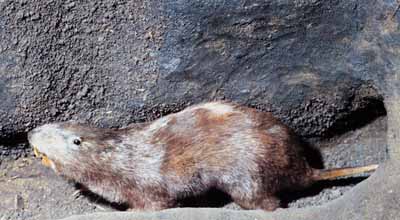
(Geomys bursarius)
Interesting facts:
Plains pocket gophers can run backwards in their burrows as fast as they can run forward. They use their bare tail as a feeler when backing up in the burrows. Their loose skin lets them turn a somersault in the tunnel for a quick getaway.
Description:
The plains pocket gopher is a small, solitary (lives alone) rodent. It is 5 1/2 to 9 inches long. In Illinois, this type of pocket gopher is black, rather than yellowish brown. It has large forefeet with strong claws and toes with bristles for digging. It uses its front teeth to dig and to gnaw roots and tubers.
Habitat and behavior:
Plains pocket gophers live in pastures, grasslands, and prairies. In Illinois, they live in a 100-mile-wide band that stretches from the Mississippi River at St. Louis, and follows the south shore of the Illinois River and Kankakee Rivers northeast to the Indiana border.
The gophers choose well-drained soil that supports the growth of plants like alfalfa that have tuberous roots. Burrows are often located on embankments near roads. Most of their lives are spent underground. They dig burrows just under the surface to find roots. Every few feet they push the soil they have dug out up through the surface to remove it from the tunnel. It forms a mound.
Food:
Plains pocket gophers are vegetarians. They eat roots, tubers, bulbs, carrots and other vegetables, grass, nuts, and sometimes the green parts of plants.
Distribution and status:
Plains pocket gophers are rare, but not protected. The disappearance of most of the prairie has decreased its habitat.